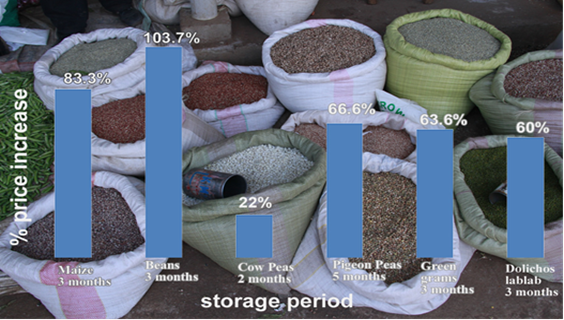Commercial Villages Post-Harvest Value Chain-Wide
Introduction
Overview

The FCI Commercial Village Model, an inclusive business model, is generating statistical evidence as an emerging vehicle for smallholder commercialization, market access, trade and a partnership platform for technology adoption. The model has been implemented for over years in eight (8) countries in partnership with 137 partners; including government agencies, development organizations, research institutions and private sector players. The model has achieved change through improved adoption of post-harvest and storage technologies e.g. (61% of smallholder cereals and legumes farmers organized into 30 Commercial Villages in Meru County, Kenya). As a result of increased adoption of proper post-harvest and storage technologies and collective marketing, the action research data reveals that the farm-gate price for beans increased by 103.7% [see figure below] after storing for 3 months.
Source: Farm Concern International, FCI, Marega Commercial Village, Meru, Kenya, Sales Progress Report, 2014
Enhanced market access for smallholder farmers has proved to contribute significantly to the reduction of aflatoxin incidences in food value chain through collective adoption of proper post-harvest and storage technologies in sub-Saharan Africa. These technologies include use of shellers, drying tarpaulin, moisture meters, hermetic storage bags, metal silos, earthen pot, sisal bags, cribs and aflatoxin test kit.
The increased adoption of these technologies has been triggered by intensive commercialization process through the Commercial Village Model, a vehicle for capacity building and training of smallholder farmers on market requirements by buyers including specific volumes and quality of commodities that has enhanced collective action by the villages. In retrospect, farmers are demanded to invest in post-harvest and storage technologies to respond to market quality requirements.
Therefore, Commercial Village Model enhances access and affordability of these technologies by smallholder farmers through participating in collective Commercial Village Savings and Investment Schemes. The savings scheme ensures farmers are saving 10% of their income from commodity sales for collective purchase of post-harvest and storage technologies at a discounted rate, upgrading of village stores and household stores where Commercial Village data shows 65% of grain is stored at household level. In addition, the model has recorded 49% women and 30% youth participation in Agriculture, trade and enterprise, and annual income growth from USD 141 (2011) to USD 2,870 (2015) per household.
FCI develops messages to influence all the value chain actors on the need to adopt better post-harvest technologies along the value chains (harvest, drying, household storage, transportation and warehousing).
